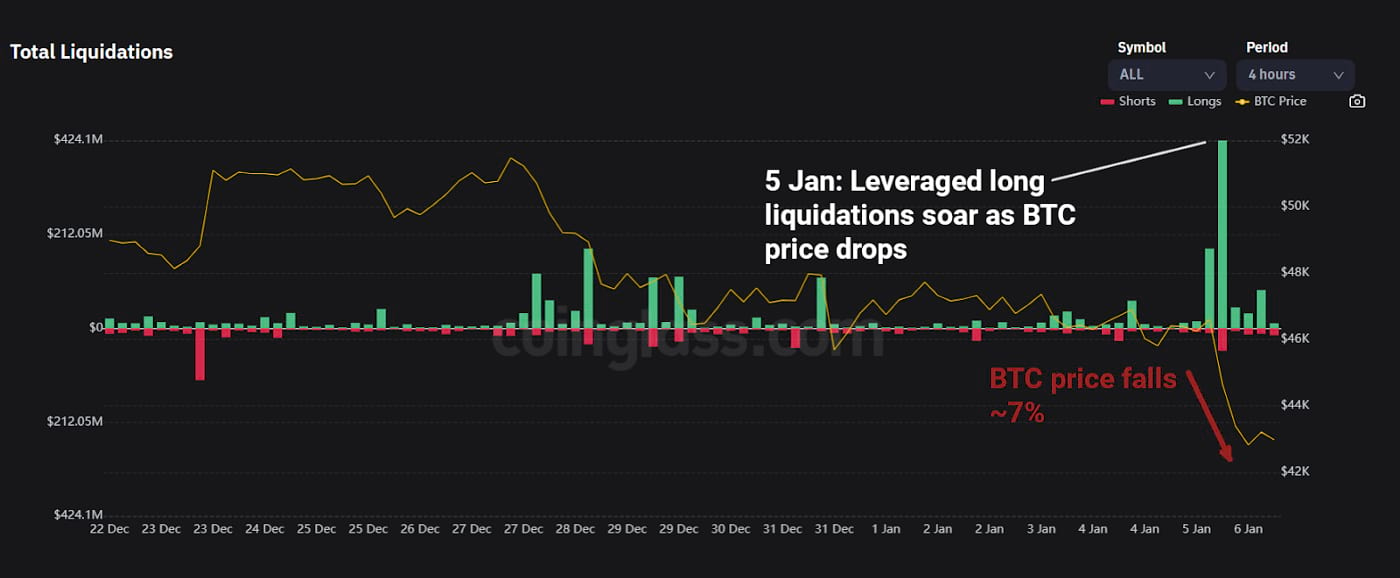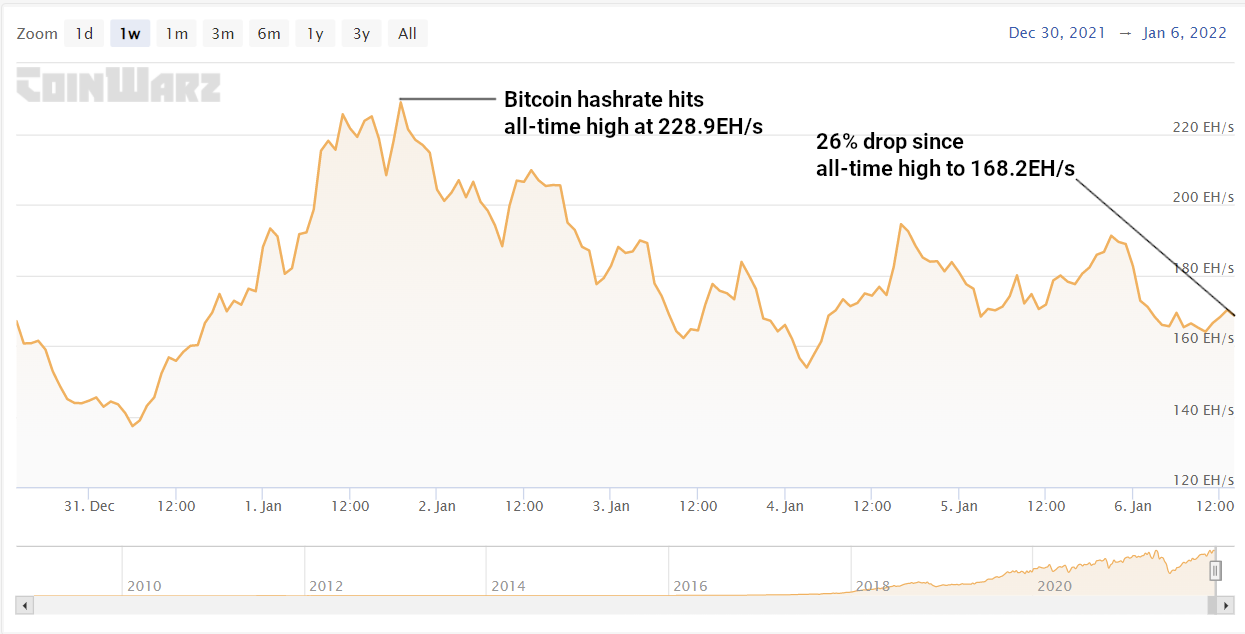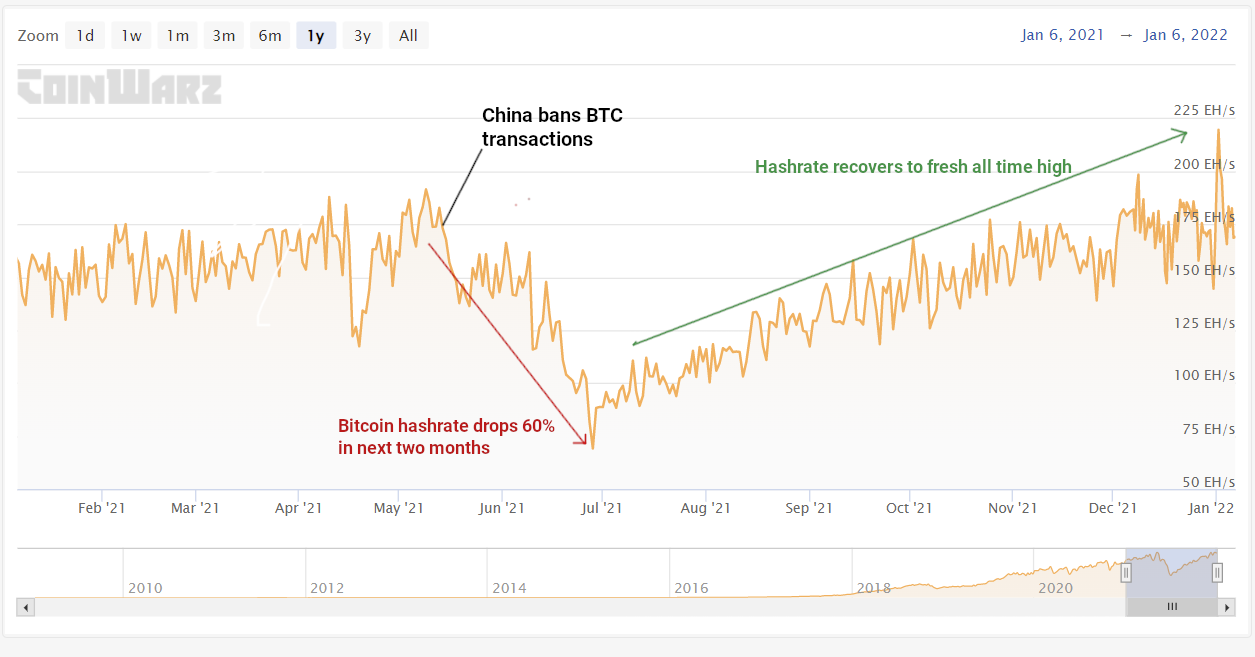
The situation in Kazakhstan is terrible for its people and we hope everyone there is staying safe.
On a financial level we think what we saw with the Bitcoin price dipping ~7% overnight is a simple supply and demand story. It’s likely we saw Kazakhstani cryptocurrency miners looking to flee the country and liquidating Bitcoin they had already mined, in order to finance that move. With a greater supply of Bitcoin hitting the market, the price fell.
Kassym-Jomart Tokayev, the president of Kazakhstan, upended Bitcoin miners’ businesses on Wednesday 5 January when he ordered the country’s largest telecom provider Kazakhtelecom to pull the plug on the nation’s internet.
The largest global Bitcoin mining pools such as AntPool and F2Pool showed an almost immediate dip.
Normally we know that quite a lot of Bitcoin supply is stored up in HODLers’ wallets and in very popular exchange traded products like our Bitcoin ETP (BTCE), and therefore isn’t available to the general market. As Brian Brooks, former acting head of the US federal banking regulator, told the House Financial Services Committee last month, something like 80% of Bitcoin holders have never sold any at all. So when there’s a sudden increase in supply it naturally depresses the price.
There is also a lot of speculative leverage in the riskier portions of the crypto daytrading market.
With supply hitting the market and the price falling suddenly, we saw a cascade of highly leveraged long positions being liquidated — and the subsequent margin calls — and more liquidations. ETPs like ours aren’t leveraged to the hilt, or leveraged at all, they are physically-backed 1:1 and so just track the price of Bitcoin and other cryptoassets very accurately, so they aren’t subject to these same kinds of risks.
More than 225,000 traders had nearly $1bn of leveraged long positions liquidated in the following 24 hours, according to Coinglass.

How do we know Kazakhstani miners dumped BTC supply onto the market? Well, it happened before, in China.
With the Kazakhstan government turning off the internet, it was widely reported that cryptominers along with everyone else were unable to get online.
As of last week, Kazakhstan accounted for around a fifth (18.1%) of the Bitcoin hashrate, that’s the amount of computing power globally that is dedicated to mining Bitcoin, verifying transactions and creating new bitcoins. These are figures from the pre-eminent researchers in the space, the Cambridge Centre for Alternative Finance.
We’re starting to see this situation represented in the Bitcoin hashrate, which has fallen 26% from its all time high of 228 EH/s to 168 EH/s in the last few days.

The same thing happened in China in May 2021, when the government started to turn off the power to crypto miners in large centres like Inner Mongolia.
At the time, the region, known for its cheap power, accounted for around 8% of global hashrate. In March 2021 the region’s provincial government cracked down on Bitcoin mining, giving businesses a two-month window to get out. The Chinese government then banned Bitcoin transactions altogether, and by July the Bitcoin hashrate had dropped 60%.
A glut of Bitcoin hit the market, a lot of it likely coming from Chinese miners looking to liquidate their holdings, and the price of 1 BTC cratered from $58,800 on 8 May to $29,700 by mid-July.
Hashrate had recovered to fresh all time highs as recently as 1 January 2022.
Bitcoin miners forced out of China had originally chosen Kazakhstan for its cheap energy prices: around $0.05Kw/h compared to jurisdictions like the US which charge in the region of $0.12Kw/h. Hong Kong-based BIT Mining sent thousands of ASIC mining machines to the state in June last year, alongside Beijing’s Canaan.

With miners operating in Kazakhstan controlling such a large proportion of the Bitcoin hashrate they now face the same kinds of decisions as those businesses in Inner Mongolia, although circumstances demand a less orderly exit and much accelerated time-frame.
Again, this story is one of simple supply and demand.
The price action this time round may be much different: yes, there is a glut of bitcoin on the market but we are seeing some seller exhaustion in the $42k region and there is likely to be a relief rally that we are watching out for. If I’m an institutional investor, I’m finding it hard to see a 2x or 3x from Bitcoin from $69k when it’s already up 5x from January to November 2021. That calculation is a lot easier now at $42k.
We’re looking to US crypto miners like Riot Blockchain to win in the short term from picking up the slack in Bitcoin hashrate from Kazakhstan-based mining operators (like Canaan) going offline, and the time necessary in moving their operations overseas. And easy-access ETFs, like our Digital Assets and Blockchain Equity ETF (KOIN) that hold a good cross section of US crypto miners will likely be the immediate beneficiaries.
WICHTIGER HINWEIS:
Dieser Artikel stellt weder eine Anlageberatung dar, noch bildet er ein Angebot oder eine Aufforderung zum Kauf von Finanzprodukten. Dieser Artikel dient ausschließlich zu allgemeinen Informationszwecken, und es erfolgt weder ausdrücklich noch implizit eine Zusicherung oder Garantie bezüglich der Fairness, Genauigkeit, Vollständigkeit oder Richtigkeit dieses Artikels oder der darin enthaltenen Meinungen. Es wird davon abgeraten, Vertrauen in die Fairness, Genauigkeit, Vollständigkeit oder Richtigkeit dieses Artikels oder der darin enthaltenen Meinungen zu setzen. Beachten Sie bitte, dass es sich bei diesem Artikel weder um eine Anlageberatung handelt noch um ein Angebot oder eine Aufforderung zum Erwerb von Finanzprodukten oder Kryptowerten.
VOR EINER ANLAGE IN KRYPTO ETP SOLLTEN POTENZIELLE ANLEGER FOLGENDES BEACHTEN:
Potenzielle Anleger sollten eine unabhängige Beratung in Anspruch nehmen und die im Basisprospekt und in den endgültigen Bedingungen für die ETPs enthaltenen relevanten Informationen, insbesondere die darin genannten Risikofaktoren, berücksichtigen. Das investierte Kapital ist risikobehaftet und Verluste bis zur Höhe des investierten Betrags sind möglich. Das Produkt unterliegt einem inhärenten Gegenparteirisiko in Bezug auf den Emittenten der ETPs und kann Verluste bis hin zum Totalverlust erleiden, wenn der Emittent seinen vertraglichen Verpflichtungen nicht nachkommt. Die rechtliche Struktur von ETPs entspricht der einer Schuldverschreibung. ETPs werden wie andere Wer
Über ETC Group
ETC Group bietet erstklassige Produkte für das Investment in digitale Werte wie Kryptowährungen - und das mit Domizil Deutschland. Mit unseren physisch hinterlegten Krypto-ETPs schlagen wir eine Brücke vom klassischen, regulierten Kapitalmarkt in die lebendige Kryptoszene. Unsere ETPs sind der Schlüssel zum Ökosystem der digitalen Vermögenswerte und vereinfachen den Investmentzugang zu Bitcoin, Ethereum und weiteren Kryptowährungen erheblich.
Die ETC Group setzt sich aus einem außergewöhnlichen Team von Finanzdienstleistungsexperten und Unternehmern zusammen, die über Erfahrung mit digitalen Vermögenswerten und regulierten Märkten verfügen. Da Produktqualität und -sicherheit im Mittelpunkt unseres Produktentwicklungsansatzes stehen, ist das Unternehmen bestrebt, kontinuierlich erstklassige börsengehandelte Produkte für institutionelle Kunden auf den Markt zu bringen.
Als Unternehmen hat die ETC Group bereits BTCE auf den Markt gebracht - das weltweit erste börsengehandelte Bitcoin-Produkt mit zentralem Clearing an der Deutschen Börse XETRA, dem größten ETF-Handelsplatz in Europa sowie DA20. Dabei handelt es sich um das weltweit erste Krypto-ETP, das einen MSCI-Index abbildet und einen Schritt in Richtung Investment-Management-Produkte darstellt. DA20 ermöglicht Anlegern ein breites Marktengagement, indem es einen Index von 20 Kryptowährungen abbildet, die etwa 85 % der Kapitalisierung des gesamten Kryptomarktes abdecken.


